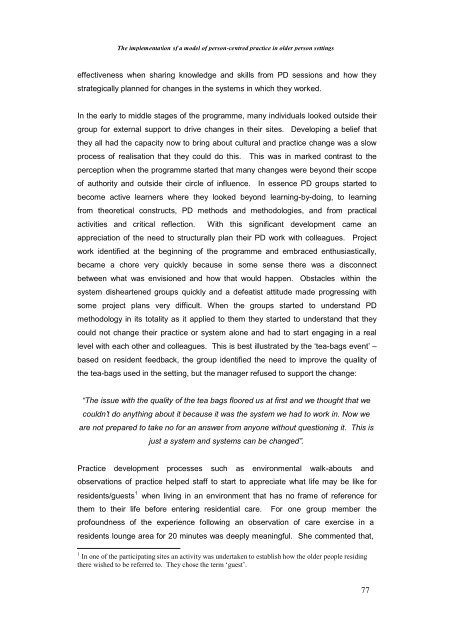The Implementation of a Model of Person-Centred Practice In Older ...
The Implementation of a Model of Person-Centred Practice In Older ...
The Implementation of a Model of Person-Centred Practice In Older ...
You also want an ePaper? Increase the reach of your titles
YUMPU automatically turns print PDFs into web optimized ePapers that Google loves.
<strong>The</strong> implementation <strong>of</strong> a model <strong>of</strong> person-centred practice in older person settings<br />
effectiveness when sharing knowledge and skills from PD sessions and how they<br />
strategically planned for changes in the systems in which they worked.<br />
<strong>In</strong> the early to middle stages <strong>of</strong> the programme, many individuals looked outside their<br />
group for external support to drive changes in their sites. Developing a belief that<br />
they all had the capacity now to bring about cultural and practice change was a slow<br />
process <strong>of</strong> realisation that they could do this. This was in marked contrast to the<br />
perception when the programme started that many changes were beyond their scope<br />
<strong>of</strong> authority and outside their circle <strong>of</strong> influence. <strong>In</strong> essence PD groups started to<br />
become active learners where they looked beyond learning-by-doing, to learning<br />
from theoretical constructs, PD methods and methodologies, and from practical<br />
activities and critical reflection. With this significant development came an<br />
appreciation <strong>of</strong> the need to structurally plan their PD work with colleagues. Project<br />
work identified at the beginning <strong>of</strong> the programme and embraced enthusiastically,<br />
became a chore very quickly because in some sense there was a disconnect<br />
between what was envisioned and how that would happen. Obstacles within the<br />
system disheartened groups quickly and a defeatist attitude made progressing with<br />
some project plans very difficult. When the groups started to understand PD<br />
methodology in its totality as it applied to them they started to understand that they<br />
could not change their practice or system alone and had to start engaging in a real<br />
level with each other and colleagues. This is best illustrated by the ‘tea-bags event’ –<br />
based on resident feedback, the group identified the need to improve the quality <strong>of</strong><br />
the tea-bags used in the setting, but the manager refused to support the change:<br />
“<strong>The</strong> issue with the quality <strong>of</strong> the tea bags floored us at first and we thought that we<br />
couldn’t do anything about it because it was the system we had to work in. Now we<br />
are not prepared to take no for an answer from anyone without questioning it. This is<br />
just a system and systems can be changed”.<br />
<strong>Practice</strong> development processes such as environmental walk-abouts and<br />
observations <strong>of</strong> practice helped staff to start to appreciate what life may be like for<br />
residents/guests 1 when living in an environment that has no frame <strong>of</strong> reference for<br />
them to their life before entering residential care.<br />
For one group member the<br />
pr<strong>of</strong>oundness <strong>of</strong> the experience following an observation <strong>of</strong> care exercise in a<br />
residents lounge area for 20 minutes was deeply meaningful. She commented that,<br />
1<br />
<strong>In</strong> one <strong>of</strong> the participating sites an activity was undertaken to establish how the older people residing<br />
there wished to be referred to. <strong>The</strong>y chose the term ‘guest’.<br />
77
















